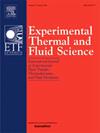Error analysis and improvement of water displacement method in measuring gas desorption volume from coal particles
IF 2.8
2区 工程技术
Q2 ENGINEERING, MECHANICAL
Experimental Thermal and Fluid Science
Pub Date : 2024-10-10
DOI:10.1016/j.expthermflusci.2024.111333
引用次数: 0
Abstract
The water displacement method is widely employed in experiments to investigate the adsorption and desorption characteristics of coal gas. However, conventional desorption apparatus faces challenges in accurately quantifying gases with low desorption rates, leading to significant inaccuracies in experimental assessments of residual gas content and adsorption–desorption hysteresis. In order to solve the issue, a new desorption device was invented to carry out isothermal ultimate desorption experiments together with the conventional device under two different equilibrium pressures with coal samples of four particle sizes. The results reveal that after 100 min, the gas desorption rate gradually decreases, with the desorption percentage of the conventional device remaining relatively constant, while that of the new device continues to rise. By the end of the experiment, the conventional device measured gas residual percentages ranging from 30 % to 50 %, whereas the new device recorded percentages between 10 % and 25 %. The lower residual percentages obtained by the new device prove the effectiveness to solve the issue that the conventional devices struggle to quantify low-rate desorption gas.
When applying the conventional device, as desorption progresses, the desorption rate decreases, and the pressure within the coal sample tank increases more slowly, which results in the difficulty for the gas to reach a pressure of 71.18 Pa to overcome fluidic constraints and enter into the graduated cylinder and ultimately accumulates in the soft, large-volume silicone pipeline. In contrast, the new device, designed with its gas outlet strategically positioned above the liquid level, bypasses the constraints of liquid forces. Additionally, the modest inner diameter of the rigid tube undergoes minimal deformation under experimental conditions. Differences in liquid forces and piping allow the new device to accumulate 71 mL less gas than the conventional device. The utilization of the new device in coal gas desorption experiments effectively mitigates experimental errors stemming from low desorption rates, thereby driving advancements in the investigation of coal seam gas parameters and residual gas content.
水置换法测定煤颗粒瓦斯解吸量的误差分析与改进
水置换法被广泛应用于研究煤气吸附和解吸特性的实验中。然而,传统的解吸装置在准确量化解吸速率较低的气体方面面临挑战,导致残余瓦斯含量和吸附-解吸滞后的实验评估严重不准确。为了解决这个问题,我们发明了一种新的解吸装置,在两种不同的平衡压力下,用四种粒度的煤样与传统装置一起进行等温极限解吸实验。实验结果表明,100 分钟后,气体解吸率逐渐降低,传统装置的解吸率保持相对稳定,而新装置的解吸率持续上升。实验结束时,传统装置测得的气体残留率为 30% 至 50%,而新装置测得的残留率为 10% 至 25%。在使用传统装置时,随着解吸过程的进行,解吸速率降低,煤样罐内的压力增加较慢,导致气体难以达到 71.18 Pa 的压力,无法克服流体限制进入刻度量筒,最终积聚在柔软的大容量硅胶管道中。相比之下,新装置的气体出口设计在液面上方,绕过了液体压力的限制。此外,在实验条件下,内径不大的刚性管变形极小。液体作用力和管道的不同使得新装置比传统装置少积聚 71 毫升气体。在煤气解吸实验中使用新装置,可有效减少因解吸率低而产生的实验误差,从而推动煤层瓦斯参数和残余瓦斯含量研究的进步。
本文章由计算机程序翻译,如有差异,请以英文原文为准。
求助全文
约1分钟内获得全文
求助全文
来源期刊

Experimental Thermal and Fluid Science
工程技术-工程:机械
CiteScore
6.70
自引率
3.10%
发文量
159
审稿时长
34 days
期刊介绍:
Experimental Thermal and Fluid Science provides a forum for research emphasizing experimental work that enhances fundamental understanding of heat transfer, thermodynamics, and fluid mechanics. In addition to the principal areas of research, the journal covers research results in related fields, including combined heat and mass transfer, flows with phase transition, micro- and nano-scale systems, multiphase flow, combustion, radiative transfer, porous media, cryogenics, turbulence, and novel experimental techniques.
 求助内容:
求助内容: 应助结果提醒方式:
应助结果提醒方式:


